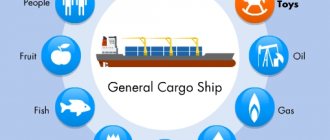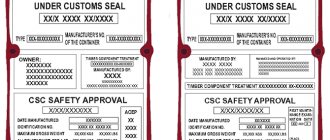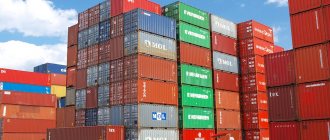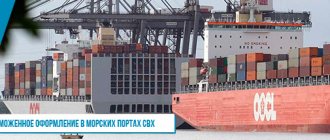The information presented in this section will help you understand some of the details of the sea transportation process (terminology, documents, conditions, cargo handling in ports, etc.).
- Bill of Lading, B/L () - the main maritime document - a waybill for the carriage of goods (issued only by a sea line or a licensed NVOCC sea carrier, the bill of lading contains the recipient and sender details, cargo data and container number, which the customer can trace, where his cargo is located);
- Shipper – sender (supplier) of cargo under the bill of lading;
- Consignee - the recipient of the cargo under the bill of lading;
- Notify party - the party that the carrier must notify about the arrival of the cargo (according to the bill of lading). This may be the recipient himself, the forwarder or another representative of the recipient at the port;
- Freight (freight) - transportation of cargo;
- Loading - loading;
- Discharging - unloading;
- Feeder is a local shipping line for transporting a container or oversized cargo over a short distance or delivering containers from/to the loading port to an ocean-going ship. When concluding a contract for long-distance sea transportation, local feeder transportation is included in the freight amount, and no additional payment is required.
- NVOCC (Non-Vessel Operating Common Carrier) is an ocean carrier that issues a bill of lading for the carriage of goods on ships that it does not own or operate, while maintaining a relationship with the operator. To date, NVOCC status is legally defined in only two countries: the USA and China. The essence of NVOCC's activities is door-to-door transportation. By offering one price for the entire shipment, NVOCC takes full responsibility for the transportation. In such a case, NVOCC issues an intermodal bill of lading, generally recognized as a sea line bill of lading.
- TEU (Twentyfoot Equivalent Unit) is a unit of cargo measurement equal to the volume of one 20-foot container. One 40ft container = 2TEU
Conditions of transportation
- CY (Container Yard, container terminal) – two options are possible: 1. Place of storage of containers before/after their further shipment, 2. Conditions of transportation upon departure/arrival - the cost of transportation includes shipping services from/to CY (freight, loading/unloading from the vessel, placement on CY, does NOT include services for receiving/departing cargo to/from CY);
- DOOR (delivery from/to door) - a condition of transportation upon departure/arrival - means that the forwarder assumes responsibilities for organizing transportation to/from the front doors/warehouse of the sender/recipient; the cost of transportation includes shipping services from/to the front doors/warehouse of the sender/recipient;
- FI (Free In, free from loading) - a condition of transportation upon departure - means that freight does not take into account the cost of loading onto the ship;
- FO (Free Out, free from unloading) - a condition of transportation at the destination - means that freight does not take into account the cost of unloading from the vessel;
- LI (Liner In, linear conditions upon departure) - means that the cost of receiving/handling cargo at the container terminal and loading onto the ship is included in the freight rate;
- LO (Liner Out, line conditions upon arrival) - means that the cost of unloading from the vessel and receiving/handling the cargo at the container terminal is included in the freight rate.
NB: The terms of the bet always consist of 2 parts - information on the conditions of departure and arrival. For example, FILO, LICY, etc.:
- FIOS - Free in / out (loading and unloading at the expense of the sender);
- FILO - Free in / Liner out (loaded at the expense of the sender / unloaded at the expense of the line);
- LIFO - Liner in / Free out (loaded at the expense of the line / unloaded at the expense of the sender);
- LILO - Liner in / out (loading/unloading due to the line - full linear conditions).
What does the freight rate depend on?
One of the most significant cost items for sea transportation is freight. This is a cargo transportation service provided by the shipowner. The freight rate is influenced by many parameters:
- 1 supply/demand on the market;
- 2 quantity of cargo;
- 3 distance between ports;
- Level 4 port dues;
- 5 cost of supplies and fuel;
- 6 type of vessel;
- 7 transportation route;
- 8 legislation of different countries.
The freight rate in some cases may also include the cost of loading and unloading operations. If the cargo follows a linear route, then the rate is easier to determine - it is calculated according to a predetermined tariff (including the Liner In and Liner Out expense items). The charter rate may also include environmental charges, such as a sulfur tax, a payment for the ship's emissions.
Fees to the base freight rate (the lines are paid on account of the freight)
- ALL IN (All Inclusive, “all inclusive”) - means that the cost of transportation includes all additional fees provided for by the conditions of transportation. For example, if we are talking about freight on LILO terms, this means that the rate, in addition to freight, loading and unloading, also includes all associated costs - BAF, CAF, etc.;
- BAF (Bunker Adjustment Factor, bunker allowance) is an additional fee to the base freight rate, the amount depends on the cost of fuel on the international market. May change monthly or quarterly. Usually quoted per TEU (for example 500 USD/TEU);
- CAF (Currency Adjustment Factor, currency allowance) is an additional fee to the base freight rate, the amount depends on changes in exchange rates. May change monthly or quarterly. Usually quoted as a % of the base freight rate;
- IMO Surcharge - surcharge for dangerous goods;
- ISPS or SEC (security charges) – port security fee;
- GRI – planned increase in the base rate from a certain date;
- THC (Terminal Handling Charges, terminal cargo handling) - initially - any terminal services for cargo handling: loading/unloading from a vessel, moving to a stack, setting up for work, etc. Currently, in practice, the following understanding of this term has developed - cargo handling services, payment for which, in accordance with the customs of the port, is made by the sender, if this is the port of departure ( oTHC - origin THC ), or the recipient, if this is the port of destination ( dTHC - destination THC );
- Heavy Lift Charge – surcharge for exceeding a certain weight of cargo (used when there is a large number of heavy loads in a certain direction);
- PCS (Port Congestion Surcharge) - a surcharge due to overload of container areas of the port;
- PSS (Peak Season Surcharge) - a surcharge due to a seasonal increase in traffic volume at a certain time of the year (“high season”);
- WarRisk (military risks) - charged at ports located in the war zone;
- WinterSurcharge (winter surcharge) - charged in ports where there is a possibility of icing of the port waters. Valid during winter.
NB: The validity period of the bid must be specified. The cost of freight is determined by the date of departure of the cargo (the date of issue of the bill of lading at the port of departure).
Dictionary of marine terms and abbreviations
A
A GT (
Agent - An agent is a person authorized to conduct business on behalf and on behalf of another person or company.
A.I.
(AllIn) “All inclusive” means that the cost of transportation includes all additional fees provided for by the conditions of transportation. For example, if we are talking about freight on CY/CY terms, this means that the rate, in addition to freight, loading and unloading, also includes all associated costs such as BAF, CAF, etc.
A RRIVAL NOTICE
- a notice that the carrier sends to the consignee before the ship arrives at the port of destination. Typically, the notice contains information about the expected date of arrival, bill of lading number, container number, cargo weight, etc.
The carrier provides notification solely on a voluntary basis to ensure uninterrupted delivery. The responsibility for monitoring the movement of the cargo and taking measures to receive it on time remains with the recipient.
B
B/L (
Bill of lading - a contract of sea transportation, a document confirming the fact of acceptance of cargo by the carrier for sea transportation and the obligation to transfer it to the consignee at the port of destination; the sender is responsible to the carrier for the correctness of the information stated in the bill of lading. The bill of lading accompanies the cargo during transportation. The original bill of lading is the document of title.
BAS
(Base Rate) - base freight rate (see also BFR). The main component of the price of sea freight transportation.
BAF ( Bunker Adjustment Factory )
Bunker surcharge is an additional charge to the base freight rate, the amount depends on the cost of fuel on the international market.
BFR
— sea freight (see also BAS).
BONDED WAREHOUSE
A warehouse under customs control, where goods are stored without being subject to state taxes: a customs warehouse or a temporary storage warehouse.
B OOKING
(Booking, Bukirovka) - booking all or part of the vessel’s cargo capacity (space on the vessel) for the transportation of cargo.
BOOKING NOTE
Application for transportation - used to reserve space and containers; the information specified in the application does not form the basis for filling out a bill of lading; after submitting the application, the applicant assumes the responsibility to provide the cargo by the specified deadline.
BREAK BULK
Transportation of a small consignment of cargo without the use of a container.
C
CAF
Currency surcharge is an additional fee to the base freight rate, the amount depends on changes in exchange rates.
C.B.M.
— Cubic meter.
C ARRIER
- a person who uses his own or leased vehicles to transport goods, on the basis of an agreement concluded with the sender.
CERTIFIED OF ORIGIN
— Certificate of origin is a certificate certifying that a given imported product was manufactured in a given place.
CFR
(Cost and Freight) - “cost and freight” is an international trade term Incoterms.
CFR delivery terms mean that the seller pays for the delivery of goods to the port, loading and freight of the vessel, and also ensures the passage of customs procedures when exporting goods (including paying duties).
The buyer pays for insurance of the goods. The risk of loss or damage, as well as additional costs after the goods pass the ship's rail, passes to the buyer. CFR delivery terms are used only in case of transportation of goods by sea or river transport.
CFS
Consolidation warehouse – 1. A warehouse in which consolidation and loading/unloading into/from sea containers is carried out. 2. Condition of transportation at departure/arrival - means that the forwarder assumes responsibilities for organizing transportation from/to CFS; the cost of transportation includes shipping services from/to CFS (freight, loading/unloading from the vessel, placement on CFS).
C HARTER
(Charter) - an agreement between the owner of the vehicle and the lessee (charterer) to rent a vehicle for the transportation of goods for a certain period or flight.
CIF
(Cost, Insurance and Freight) - “cost, insurance and freight” is an Incoterms term.
CIF delivery terms are largely identical to CFR terms. In addition to liability under CFR terms of delivery, the seller for CIF terms must obtain a transferable insurance policy to cover the risks associated with the delivery of cargo by insurance companies.
The seller's responsibility for the goods ends when the goods have been delivered to the ocean carrier or loaded on board the vessel, depending on the terms of the contract.
C.I.P.
(Carriage and Insurance Paid to) - “freight / transportation and insurance paid to” - the international trade term Incoterms.
The term means that the seller will deliver the goods to a named carrier. In addition, the seller is obliged to pay the costs associated with transporting the goods to the named destination.
The seller's responsibility ends when he delivers the goods to the carrier nominated by the buyer. The buyer bears all risks and any additional costs incurred after the goods have been delivered.
This term is similar to CPT, except that the seller also pays for the insurance. Under the terms of CIP, customs procedures for exporting goods are the responsibility of the seller.
C. _ O. _ C. _
(Carrier's Owned Container) the container is the property of the carrier.
The cost of using the container is included in the freight.
CONSIGNEE
Recipient - the person to whom the goods are transferred at the destination.
CPT
(Carriage Paid to) - “Freight/carriage paid to” is an international trade term Incoterms that applies to all modes of transport, including intermodal transport.
The seller bears the costs of freight and transportation to the destination. The buyer pays for cargo insurance. Risks pass when the goods are delivered to the first carrier.
CUC
(Chassis Using Charge) - charge for using the chassis.
CUT OFF TIME
Control time for cargo delivery to the terminal and execution of relevant documents for the flight.
C.Y.
Container terminal – 1. A place where containers are stored before/after their further shipment. 2. Condition of transportation upon departure/arrival - means that the forwarder assumes responsibilities for organizing transportation from/to CY; the cost of transportation includes shipping services from/to CY (freight, loading/unloading from the vessel, accommodation on CY).
D
DC
Dry container, Dry Container – type of container. The most common type of container is a rectangular box of standard dimensions made of corrugated metal with doors at one end, usually covered with a wooden floor inside.
DDF
(Destination - Documentation Fee) - fee for processing documents at the port of delivery.
DDP
(Delivered, Duty Paid) - “delivered, duty paid” - Incoterms delivery terms. Used to indicate the place of arrival.
The seller bears all risks, all costs of delivery of goods (taxes, duties, etc.), responsibility for damage and loss of goods, including duties and other import payments until the goods are delivered to the specified place in the buyer’s country. The seller is also responsible for customs clearance.
The contract may include provisions that exempt the seller from paying for certain additional formalities. This type of distribution of responsibility can be used regardless of the type of supply.
DEMURRAGE
Demurrage is a fee for excess delay of a container, charged for each day of detention.
D ETENTION
(Detention) - penalties levied for excess use of a container from the moment it is removed from the terminal until the empty container is returned to a place agreed upon with the owner of the container.
DHC
(Handling Charge - Destination) - costs for transshipment at the delivery port.
D ISBURSEMENT ACCOUNT
(Disbursement account) - a document containing a list of expenses incurred for services at the port.
DIM
(Dimensions) - dimensions.
DISCHARGING
— unloading.
DOCS
(Documentation), Docs Fee - local line agent fees for document processing. May be charged both per bill of lading and per container.
DOOR - DOOR
Delivery to the door - a condition of transportation upon departure/arrival - means that the forwarder assumes responsibilities for organizing transportation to/from the front doors/warehouse of the sender/recipient; the cost of transportation includes shipping services from/to the front doors/warehouse of the sender/recipient.
DROP-OFF CHARGE
A fee for returning a carrier-owned container to a location other than the destination stated on the carrier's bill of lading.
E
ETA
Estimated arrival date.
ETD
Estimated departure date.
EXW
(Ex Works) - “from the place of work, pickup” - an Incoterms term. The seller's responsibility ends when the goods are transferred to the buyer or the carrier hired by him at the seller's premises (factory, warehouse, store, etc.). The seller is not responsible for loading the goods onto transport. The buyer bears all costs for removing the goods from the warehouse, transportation, customs clearance, etc.
F
F.A.S.
(Free Alongside Ship) - “Free along the side of the ship” is an international trade term Incoterms. The seller bears the costs of delivery to the port of departure.
The seller fulfills his obligations to deliver the goods at the moment when the goods are placed alongside the ship at the berth (at the agreed port of shipment).
The buyer pays the costs of loading, chartering the vessel, insurance, unloading and delivery to the destination. Risks pass at the moment of delivery to the berth of the loading port.
FCA
Free Carrier - 'Free Carrier named place' is an Incoterm trade term meaning that the seller fulfills his obligation to deliver when he delivers the goods, cleared for export, to the buyer's nominated carrier at the named place.
The specified place of delivery affects the obligations to load and unload the goods at such place. If delivery takes place at the seller's premises, the seller is responsible for shipment. If delivery occurs at any other location, the seller is not responsible for shipment.
FCL
(Full Container Loading) - a container filled with the cargo of one recipient.
Full container loading by one sender to one recipient.
FEEDER
Feeder – a vessel/line serving ports remote from the main transport hubs.
FEU
Equivalent to the volume of a forty-foot container.
FFC
(Freight Forwarder Commission / Brokerage) - brokerage commission.
FI
“Free of loading” – a condition of carriage upon departure – means that the freight does not take into account the cost of loading onto the ship.
FICY
(Free In / Container Yard) - loading at the port of departure at the expense of the sender/recipient, delivery to the container terminal at the expense of the line.
FIFO
(Free In / Free Out) - loading and unloading at the expense of the sender/recipient.
FILO
(Free In / Liner Out) - loading at the expense of the sender, unloading at the expense of the line.
FIOS
(Free In / Out) - loading and unloading at the expense of the sender/recipient.
F.O.
“Free from landing” – a condition of carriage at destination – means that the freight does not take into account the cost of unloading from the vessel.
FOB
(Free On Board) - “Free on board, literally - free on board the ship” - an international trade term Incoterms. The seller is obliged to deliver the goods to the port and load them onto the ship specified by the buyer.
The costs of delivering the goods on board the vessel are borne by the seller. In some ports, for FOB deliveries, the buyer bears the loading costs.
The risk of accidental loss of property or damage to it rests with the seller - until the goods cross the side of the ship, and with the buyer - from that moment. As a rule, title to the goods passes from the seller to the buyer at the same time as the risk passes.
FOR
departure station “Free in the wagon/on the platform” – a condition of carriage upon departure – means that the agreed freight rate does not include the cost of loading onto the platform/wagon, fitting wagons, etc.
FR FLAT RACK
– a type of container without side walls and roof.
F REIGHT
— Freight is a fee for the transportation of goods, also known as SEA (Sea freight), O/F (Ocean Freight).
FREIGHT COLLECT
Freight is paid by the recipient.
FREIGHT PREPAID
Freight is paid by the sender.
G
GENERAL CARGO
General cargo is cargo that can be recalculated, i.e. cargo packed in containers or piece cargo, including: boxes, bags, barrels, bales, containers, etc.
GRI
An additional fee to the base freight rate, set in accordance with the tariff policy of the linear conference, is, as a rule, seasonal in nature.
GROSS WEIGHT
— Gross weight is the weight of the goods together with internal packaging (inseparable from the goods before its consumption) and external packaging (boxes, bags, barrels, etc.).
H
HC
High Cube is a high-capacity container. See container types.
HLC
(Heavy Lift Charge) - a surcharge for exceeding a certain weight of cargo.
I
IMO SURCHARGE
— surcharge for dangerous goods.
Endorsement
(Endorsement) - an endorsement on the back of a security, according to which the rights under this security are transferred from one person to another.
The person making the endorsement is called the endorser. There is a distinction between full (nominal) endorsement and bearer endorsement, when the endorsement does not contain the name in whose favor the endorsement is made, i.e. it consists of one signature of the endorser.
The objects of transfer through endorsement can be bills, checks, bills of lading and other securities.
INCOTERMS
(International Commercial Terms) (Incoterms) is a collection of international trade terms published by the International Chamber of Commerce.
The dictionary contains terms for the basic terms of delivery related to the transportation process, registration of deliveries, etc.
IN-BOND
Not cleared through customs (about the product).
ISPS
— port security fee.
L
Laytime
(Lay time) - the period during which the carrier provides a ship for loading cargo and keeps it under loading without additional payments to freight.
Determined by agreement of the parties to the charter, in the absence of such agreement by the terms usually accepted at the port of loading.
LCL
(Less Container Loading) Partial loading of a container, in one container there is cargo from several senders to several recipients, the so-called consolidated cargo.
LI
(Liner In) Linear conditions for departure - conditions under which the forwarder provides the following services, the cost of which is included in the freight rate: removal of the container from the vehicle (road, railway), placement at the terminal (CY), loading onto the ship.
LI-DOOR
(Liner in / Door) - loading at the port at the expense of the line, delivery to the client’s “door”.
LIFO
(Liner In / Free Out) - loading onto the vessel at the expense of the line, unloading at the expense of the client.
LILO
(Liner In / Liner Out) - loading and unloading due to the line, i.e. included in the freight rate - full line terms.
L.O.
Linear conditions upon arrival - conditions under which the forwarder provides the following services, the cost of which is included in the freight rate: unloading from the vessel, placement at the terminal (CY), loading onto a vehicle (auto, railway).
L OADING
- loading onto the ship.
LUMP SUM
— the total amount for several payments at once.
M
M ANIFEST
(Manifest) - a ship's document containing a list of bills of lading. Required for provision to customs, as well as agents and stevedores at ports of destination. It usually includes the following data: name of the vessel, port of loading, bill of lading numbers, name, weight, volume and quantity of cargo for each bill of lading, names of shippers and consignees of the cargo, marking of the cargo.
MOTHER VESSEL
Large-tonnage linear vessel serving ports with large cargo turnover. Literally the mother ship.
M.T.
Metric ton = 1000kg.
MV
(Mother Vessel) is a large-capacity linear vessel serving ports with large cargo turnover. Literally the mother ship.
N
N OTIFY PARTY
- the column in the bill of lading where the party that the carrier must notify about the arrival of the cargo is entered. As a rule, this is the freight forwarder or other representative of the recipient at the port.
NVOCC
A carrier who owns a certain amount of cargo space on a ship that he does not own or operate, and has the right to issue on-board bills of lading.
O
ODF
(Origin - Documentation Fee) - fee for processing documents at the port of departure.
O/F
(Ocean Freight) - sea freight, also known as SEA (Sea freight), FREIGHT.
OGC
Oversized cargo.
OHC
(Origin - Handling Charge) - costs for transshipment at the port of departure.
O RDER BILL OF LADING
— An order bill of lading is a bill of lading under which the cargo is transferred either to the “order” of the shipper, or to the “order” of the consignee, or to the “order” of the bank, or according to the endorsement of the person whose “order” it was drawn up.
If the order bill of lading does not indicate that it is drawn up to the “order” of the recipient, then it is considered to be drawn up to the “order” of the sender. The bill of lading and, accordingly, the right to the cargo is transferred to another person using an endorsement - an endorsement.
O.T.
Open top is a type of container. See container types.
P
PCS
(Port Congestion Surcharge) - a surcharge due to overload of container areas of the port.
PICKUP _
— collection of a loaded container (cargo) from the sender.
PSE
(Port Security Charge - Export) - security charge at the port during export.
P.S.S.
(Peak Season Surcharge) - a surcharge due to a seasonal increase in traffic volume at a certain time of the year.
POD
Unloading port.
POL (
Port of loading) Port of loading.
Q
Q UALITY CERTIFICATE
— Quality certificate is a document confirming the product’s compliance with quality indicators, technical characteristics, safety requirements for human life and health, and the natural environment, stipulated by the terms of the contract.
R
RAMP
Ramp – 1. A device for moving cargo from one type of transport to another. 2. Condition of transportation at departure/arrival - means that the forwarder assumes responsibilities for organizing transportation from/to the ramp closest to the sender/recipient; the cost of transportation includes services for sending from/to the ramp (freight, loading/unloading from a vessel, terminal services, loading onto road/railway transport, delivery to/from the ramp closest to the recipient/sender).
REPO
Return of an empty container to the nearest carrier's drain after unloading. RF Reefer container.
RF
(Reefer Container) - A refrigerated container is a type of container designed for transporting goods that require temperature control.
S
S.E.A.
(Sea freight) – sea freight, also known as O/F (Ocean Freight); FREIGHT
SEC
(Security Charges) - port security charge.
SHIPPER
Consignor is the person who actually or nominally provides the cargo for transportation, as well as sending instructions to the carrier.
SHIPPING REQUEST
Instructions for sending cargo are the basis for filling out the bill of lading.
S. _ O. _ C. _
(Shipper Owned Container) The container is the property of the sender (client).
S TATEMENT
(Statement) - a document drawn up instead of a time sheet in cases where there are no necessary conditions for recording and calculating lay time.
Contains data on the time of arrival of the vessel at the port, the use of lay time, indicating the duration and reasons for breaks and downtime. According to the statement, a timesheet is drawn up and settlements are made with charterers for demurrage and dispatch.
STC
(Said To Contain) - stated to contain.
STORAGE _
— rate for excess storage of cargo at the port. It is counted from the moment of unloading at the terminal until the moment of removal from the terminal. Charged at port rates. Usually quoted per TEU and has an increasing scale (the longer the cargo is in the port, the more expensive each next day of storage).
STUFFING
Stuffing – loading a container.
T
TC
(Tank Container) - A tank container is a type of container designed for transporting gases and liquid cargo.
TEU
(Twentyfoot Equivalent Unit) - Equivalent to the volume of a twenty-foot container. A unit of cargo measurement equal to the volume of one 20-foot container. Volume of one 40-foot container = 2TEU.
Often used in assessing freight turnover.
THC
(Terminal Handling Charges) Terminal handling of cargo - initially - any terminal services for cargo handling: loading/unloading from a vessel, moving to a stack, setting up for work, etc. Currently, in practice, the following understanding of this term has developed - services processing of cargo, payment for which, in accordance with the customs of the port, is made by the sender, if this is the port of departure (oTHC), or the recipient, if this is the port of destination (dTHC). If we talk about container cargo, then these are operations for loading and unloading containers.
The cost of transhipment, as a mandatory surcharge, is added to the basic sea freight rate.
T IMECHARTER
(Time charter) - an agreement to charter a vessel for a time. The shipowner provides the charterer with a vessel for a certain period of time for an agreed fee.
The owner of a vessel on a time charter, as a rule, bears the costs of maintaining the ship's crew, maintaining the vessel in a serviceable condition and insuring it.
The charterer, in addition to paying the shipowner for the use of the vessel, assumes payment for bunkers, water, port and canal dues, and other current and operating expenses.
TIMESHEET _
(Timesheet) - a list of laytime records for cargo operations.
The timesheet is drawn up at each port of unloading/loading of the vessel and signed by the captain and the charterer’s representative. Timesheet is the basis for calculating demurrage and dispatch.
TKL
Condition of transportation at departure/arrival - means that the forwarder assumes responsibilities for organizing transportation from/to transshipment equipment at the port of departure/destination; The cost of transportation includes, in addition to freight, loading/unloading from/to the vessel, and does not include delivery/transportation to/from reloading equipment. These conditions of transportation are often used in ports where container terminals (CY) are located away from the quay wall line and delivery to/from the loading/unloading site is an additional operation.
TRANSHIPMENT
Transshipment is a change at a transit port of a shipping line for delivery from/to a port not directly served by the line.
U
UN CODE
UN number is a four-digit number used to identify a substance or group of substances according to the classification of dangerous goods developed by the Committee of Experts on the Transport of Dangerous Goods of the United Nations Economic and Social Council under the Recommendations on the Transport of Dangerous Goods.
W
W ARRISK
— additional fee for military risks, levied in ports located in the war zone.
WAY BILL
A waybill is a contract of carriage, as well as a bill of lading, a document confirming the fact that the carrier has accepted the cargo for carriage by sea and the obligation to transfer it to the consignee at the port of destination; the sender is responsible to the carrier for the correctness of the information stated in the bill of lading. The consignment note accompanies the cargo during transportation. Unlike a bill of lading, an invoice cannot be a document of title.
W HARFAGE
- port duty. Payment by the shipowner for the entry of the vessel into the port.
W.M.
The basis for charging freight is weight or volume, whichever is greater (weight or volume).
W.S.C.
(Winter Surcharge) - a winter surcharge, charged in ports where there is a possibility of icing of the port water area. Valid during winter.
Additional terms and fees
Additional terms and charges are paid to local line agents usually through port forwarders.
Demurrage - demurrage, or penalties levied for excess use of a container from the moment it is unloaded at the terminal until the empty container is returned to the port (for import) or from the moment an empty container is received for loading until the loaded container is loaded onto the ship (for export).
Depending on the line, the period of container use can sometimes be divided into Demurrage and Detention . Then Demurrage is penalties levied for excess use of a container from the moment it is unloaded at the terminal until the moment it is removed from the terminal. Detention - penalties levied for excess use of a container from the moment it is removed from the terminal until the empty container is returned to the port.
AdministrativeFee = B/LFee = DocsFee (other designations are possible) - local line agent fees for document processing. May be charged per bill of lading or per container.
What other costs may affect shipping costs?
In addition to the key cost items listed, the sender may incur additional costs. So, the shipping cost may be affected by:
Costs of Deficiency
These are additional shipping costs that arise due to the limited resources available at the port. For example, there is a shortage of containers or equipment for loading and unloading.
Overload
They can also significantly increase expense items. If it is planned to move cargo from one ship to another or to rail transport, the shipper may incur costs for this if such a condition is in the contract.
Seasonality
Seasonality affects the efficiency and cost of maritime transport. Demand for sea transportation increases significantly from February to August - this is the period of greatest activity for water transport.
Itinerary
Also has an impact on the shipper's costs. For example, when transporting cargo along northern routes, the services of icebreakers may be required to clear the ship’s path. There are also paid channels (for example, Suez), for which one of the parties to the transaction will have to pay.
Cargo stowage on board
An additional cost item may be the procedure for stowing cargo on board. Leveling is often required, which is not a free procedure.
Mixed swimming
A situation in which several waterways are used at once. This can be river, sea and ocean routes. There are universal vessels that allow goods to be transported along several routes, but in other cases mixed navigation will require reloading.
Speed
This is not the strongest feature of maritime transport. But some customers may request expedited transit, which will result in additional costs for the shipper.
Additional port charges
Port surcharges are paid to the port, usually through port forwarders, and may be collected directly by the port or by local line agents.
- Storage – rate for excess storage of cargo at the port. It is counted from the moment of unloading at the terminal until the moment of removal from the terminal. Charged at port rates. Usually quoted per TEU and has an increasing scale (the longer the cargo is in the port, the more expensive each next day of storage).
- Putting up for inspection is the rate for the work of putting the container on the inspection site (customs, sanitary, etc.). Charged according to port rates, in fact.
- Additional operations – port rates for any work not provided for in the usual container handling scheme (repacking, weighing, sealing, labeling, etc.). They are charged according to the port rates, in fact.
How to accurately determine shipper costs?
All of the above costs for sea transportation can be distributed between the consignee and the shipper by agreement. In large-scale sea transport, the entire organization of transportation can often lie with several senders at once (the situation is common in the international transport of consolidated cargo). The most important role is played by the documentation drawn up by the parties during the cooperation, and the specific obligations assigned to the individual sender or recipient. It is in the contract that the specific responsibilities of the sender are spelled out, which makes it necessary to carefully study the clauses of the transaction to determine the exact costs.
No less important are the conditions in the transport expedition agreement and in additional agreements on tariffs. They indicate both the basic cost of shipping services and tariffs for potential additional costs. Correctly formulated terms of a trade contract, transport expedition and customs representative agreements protect the interests of the shipper and consignee from unaccounted expenses.
Don’t have the experience and necessary knowledge to organize sea cargo transportation at minimal cost? Logistics specialists will help you find the optimal solution. Leave a request to receive a calculation, we will contact you within 24 hours.
Sincerely, Zakir Dosaev FEC Operator
Was the article useful? Share with your friends:










